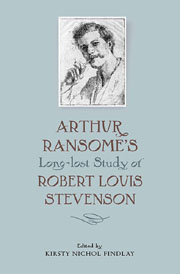Book contents
- Frontmatter
- Contents
- List of Illustrations
- In memory of David Ian Sewart 1944–2008
- Acknowledgements
- Introduction: A Context for Arthur Ransome's Robert Louis Stevenson: A Critical Study
- Arthur Ransome, Robert Louis Stevenson: A Critical Study
- Part I Biographical Summary
- Part II Writings
- Appendices
- Index
Introduction: A Context for Arthur Ransome's Robert Louis Stevenson: A Critical Study
from In memory of David Ian Sewart 1944–2008
Published online by Cambridge University Press: 05 February 2013
- Frontmatter
- Contents
- List of Illustrations
- In memory of David Ian Sewart 1944–2008
- Acknowledgements
- Introduction: A Context for Arthur Ransome's Robert Louis Stevenson: A Critical Study
- Arthur Ransome, Robert Louis Stevenson: A Critical Study
- Part I Biographical Summary
- Part II Writings
- Appendices
- Index
Summary
Parcel Post
On the first day of May 1914 a stout brown-paper parcel was dispatched by post from G. H. Harris, First-Class Boot and Legging Maker, The Strand, London W.C., ‘under Savoy Hotel’, to A. Ransome, Esq: at Manor Farm, Hatch, Tisbury, Wiltshire. The thirty-year-old Arthur Ransome was living at Hatch with his first wife Ivy and their three-year-old daughter Tabitha. He was eagerly awaiting the arrival of the parcel. Writing to his mother, he had longingly described the ‘Brands essence, A1 pair of brown walking boots, smart ones, that I have long coveted’. They would need to be tough and serviceable, since he was about to spend several summer months in Russia. It would be his second visit there; he was going to write a book about St Petersburg. Mr Harris's first-class boots would be just the thing.
Very soon after the arrival of the parcel, the stout brown paper of which it had been made was turned inside out and trimmed in order to wrap another, somewhat smaller, parcel. This time it was full of handwritten pages. It was elaborately fastened with string, and the knots sealed with sealing-wax of two colours, red and black. Ivy Ransome addressed the parcel in her firm and florid hand to ‘The Manager, Parr's Bank, Regent Street, London, W.’, adding ‘to be delivered on demand to – Arthur Ransome, Esq: or Mrs. Arthur Ransome’.
- Type
- Chapter
- Information
- Publisher: Boydell & BrewerPrint publication year: 2011



